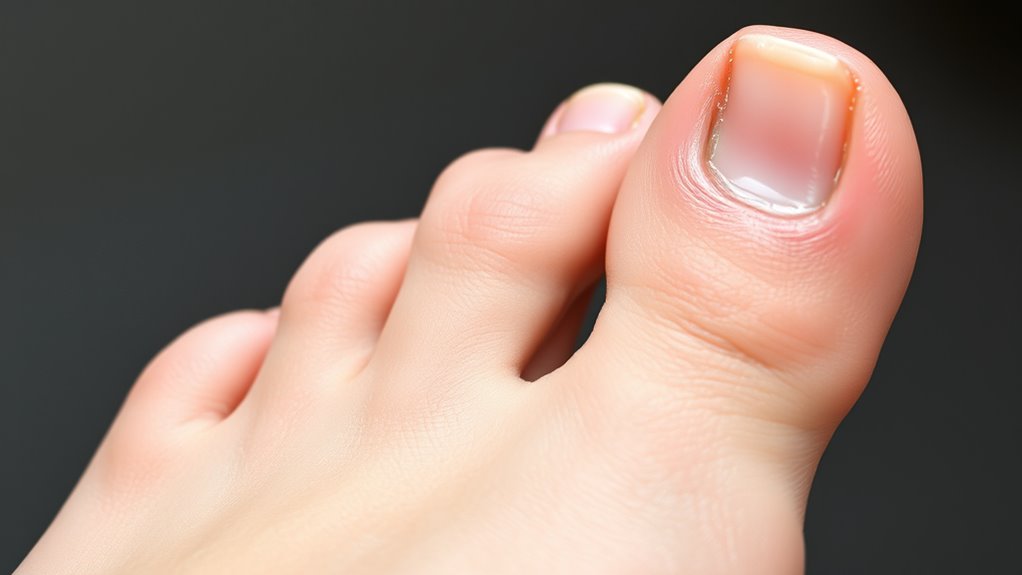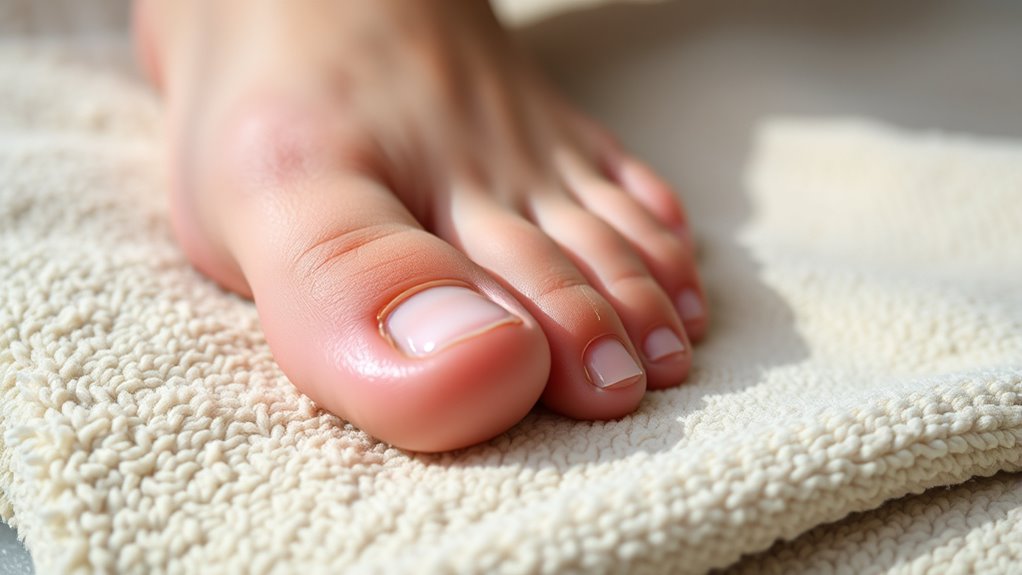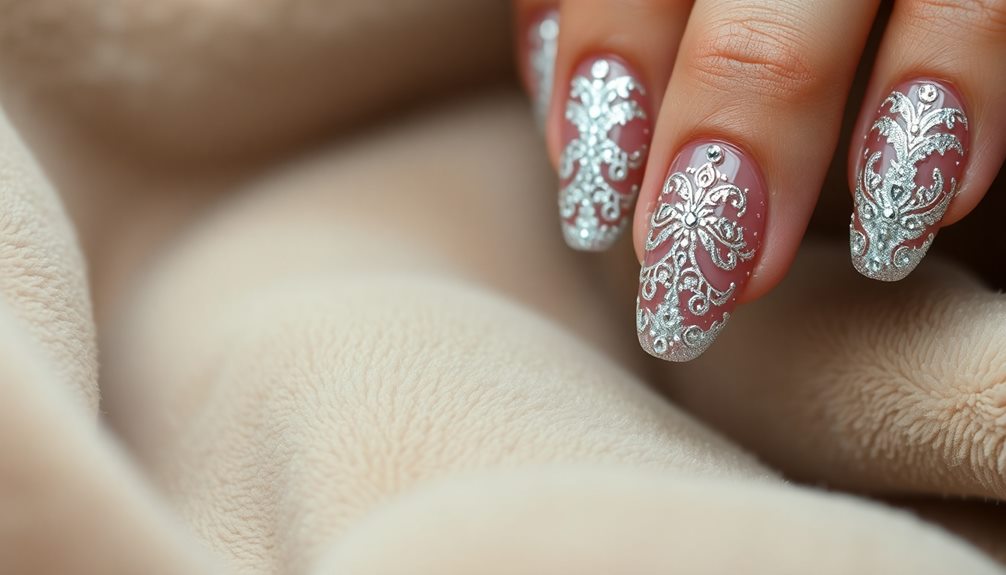To prevent ingrown toenails, make sure your shoes fit well and avoid tight or pointed footwear. Trim your nails straight across and don’t cut them too short to prevent jagged edges. Keep nails clean and dry, soak your feet in warm water if you notice redness or swelling, and apply antibiotic ointment if needed. Seek professional help if you experience persistent pain, signs of infection, or worsening symptoms—knowing when to act early can save you pain and trouble later.
Key Takeaways
- Trim toenails straight across and avoid rounding or cutting too short to prevent ingrowth.
- Wear properly fitted shoes with wide toe boxes and soft insoles to reduce pressure on toes.
- Soak feet in warm water and apply antibiotic ointment at signs of infection or discomfort.
- Seek professional medical help if redness, swelling, pus, or persistent pain occur.
- Early intervention prevents complications; consult a podiatrist for safe removal or persistent issues.

Ingrown toenails occur when the edge of your toenail grows into the surrounding skin, causing pain, swelling, and sometimes infection. You might notice tenderness around the nail, redness, or even pus if an infection develops. To prevent this uncomfortable condition, paying attention to your footwear choices and nail trimming techniques is essential. Your shoes should fit well—neither too tight nor too loose. Tight footwear puts pressure on your toes, encouraging the nail to grow into the skin, especially if your shoes squeeze the front of your foot. Opt for shoes with a wide toe box, soft insoles, and good support to reduce the risk. Avoid high heels or pointed shoes that crowd your toes and increase pressure on your nails.
When it comes to nail trimming, how you cut your toenails is just as important as what shoes you wear. Always trim your nails straight across, avoiding rounding the edges or cutting them too short. Cutting into the corners creates a sharp edge that can easily dig into the skin, leading to an ingrown toenail. Use clean, sharp nail scissors or clippers, and don’t tear or rip the nails. After trimming, gently smooth the edges with a nail file, ensuring there are no jagged or sharp points that could cause the nail to grow improperly. Keep your toenails at a moderate length—short enough to prevent snagging or digging into the skin, but not so short that the skin is exposed or the nail is weakened. Regular attention to toenail care can also promote healthier growth by preventing damage or irregularities.
Proper footwear choices and nail trimming techniques work together to minimize the risk of developing ingrown toenails. If you notice redness, pain, or swelling around your toenail, don’t ignore it. Taking early steps—like soaking your foot in warm water to reduce swelling and applying an antibiotic ointment—can help. However, if the condition worsens, if you see signs of infection, or if you experience persistent pain, it’s time to see a healthcare professional. A podiatrist can safely remove the ingrown portion of the nail or suggest other treatments to prevent recurrence. Remember, early intervention is key to avoiding more serious complications, so pay close attention to your footwear choices and nail care routines. Incorporating sound scientific principles into your routine can further support healthy nail growth and prevent future issues.
Frequently Asked Questions
Can Ingrown Toenails Be Caused by Fungal Infections?
Yes, fungal infections can cause ingrown toenails. Fungal infections often lead to nail discoloration, thickening, and crumbling, which can make the nail more prone to growing into the surrounding skin. If you notice persistent nail discoloration or thickening, it’s important to seek treatment. Untreated fungal infections can worsen, increasing the risk of ingrown toenails and other complications, so prompt care helps prevent discomfort and further issues.
Are There Specific Shoes That Prevent Ingrown Toenails?
Yes, choosing proper footwear with a wide toe box design can help prevent ingrown toenails. Look for shoes that fit well without squeezing your toes, allowing space for natural movement. Avoid tight or narrow shoes, especially around the toe area. Proper footwear reduces pressure on your toes and minimizes the risk of ingrown nails, making it easier to keep your feet healthy and comfortable.
How Does Diabetes Affect Ingrown Toenail Treatment?
Did you know that about 25% of people with diabetes develop foot ulcers? Diabetes can critically impact ingrown toenail treatment because of diabetes-related complications like impaired healing. You might experience increased risk of infection and slower recovery. It’s essential to monitor your foot health carefully, seek prompt medical attention, and follow your healthcare provider’s advice to prevent complications from ingrown toenails and other foot issues.
Can Home Remedies Fully Cure an Infected Ingrown Toenail?
Home remedies can help manage an infected ingrown toenail, but they usually can’t fully cure it, especially if the infection is severe. You should focus on infection control by soaking your toe in warm salt water, keeping it clean, and avoiding pressure. However, if symptoms worsen or persist, it’s best to see a healthcare professional for proper treatment, as an untreated infection can lead to serious complications.
What Are the Risks of Attempting to Remove an Ingrown Toenail at Home?
Attempting home removal of an ingrown toenail can be risky, especially if you believe it’s a simple fix. Home removal increases the infection risk because improper techniques can introduce bacteria or worsen the condition. Even if you’re convinced you can do it safely, you might cause more pain or damage. It’s best to seek professional help to prevent complications and guarantee proper treatment, avoiding unnecessary risks.
Conclusion
Take control now, or risk your toenails turning into a battlefield! Ignoring ingrown toenails can lead to unstoppable pain, serious infections, and even permanent damage. Don’t let tiny toenails ruin your life—fight back with prevention and timely care. When in doubt, see a pro before it spirals out of control. Your toes deserve to be pain-free and happy—so act today or prepare for a future filled with agony!









